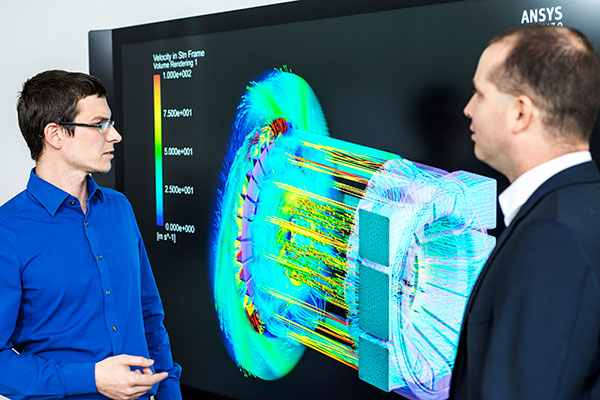Fascinating World of TSA Production
How we create our motors
Our mission starts with the concept of the vehicle manufacturer. Before a rail vehicle can be equipped with a complete drive or a bus with an e-motor, several requirements need to be examined in advance. Accompany us along the development process of our electric drives!
Feasibility check
Creating a good concept is one of the most important steps. At this point, we define rough dimensions such as length and diameter, along with a cooling concept. Based on these parameters, we can calculate whether the electric motor is suitable for the intended use.

Electromagnetic calculation
In this step, we check the functional configuration of the motor. At TSA, we have a wide portfolio of simulation options such as: electromagnetic simulation using analytical and numerical methods, drive cycle analysis for thermal behavior and energy consumption, prediction of harmonic losses at the inverter and analysis of short-circuit behavior.
Most of the programs used for calculation were developed by TSA.

Customized design
Which is the best way to position the motor in the bogie? Is there enough space for installation and accessibility?
In order to facilitate component integration, we accompany you along these important planning steps and find the correct solution with you.
Even at this stage of development, calculations are essential. Numeric simulations such as flow calculations for various cooling types (forced ventilation, self-ventilated, liquid cooling) and simulations regarding temperature, vibration and strength ensure that your motor will meet your expectations.

Rapid Prototyping
Rapid prototyping through 3D printing can also be used to quickly investigate and test various design options. This way it is possible to determine at a very early stage how the new machine will behave. For us, this is the optimal process to develop the right motor for you as fast as possible.

Procurement
We set great value on a sustainable value chain. Therefore, we obtain materials predominantly from Europe. If this is not possible, we import materials by rail from different countries around the world.

‘For us, three factors are important:
human, machine, material.’
Production and various product tests
At our plant in Wiener Neudorf, we have an enormous depth of added value. Lean Management, optimization of value stream and layout, digitalization and automation are the core contents of our Production Roadmap.
Customized stator and rotor metal sheets are stamped from electrical steel sheets weighing several tons. After this step, stators and rotors take separate production paths.

Stator production
The manufacturing of stators begins with the stacking of steel sheets. These are then welded by quality controlled robots and by our technical experts. After this step, the stator undergoes processes that prepare it for the installation of the coils.

Coil production
Another manufacturing process highlight is our coil production. This is carried out almost entirely at our subsidiary Traktionssysteme Bosnia d.o.o. in Tuzla. We use high-quality materials that are processed by hand into shaped or round-wire-coils that utilize every tenth of a millimeter of space in the groove of the stator. This step is critical to provide power density, efficiency as well as durability of our motors.

Rotor production
In the meantime, the rotor unit has been assembled. The rotor metal sheets have been drawn onto the shaft as a package, so the next step is to manufacture the squirrel-cage from high-quality copper, and finally machining, spinning and balancing it. In permanent magnet motors, magnets are inserted into the prefabricated rotor metal sheets instead.

Surface coating
Another in-house core competence is surface coating and impregnation. In 2020, Traktionssysteme Austria purchased a new industrial painting system for the company headquarters in Wiener Neudorf. Ongoing investments in our production facilities ensure that we can also meet future quality requirements.

Final assembly
One of the most comprehensive steps is the final assembly. Here our highly trained and skilled workers assemble all components into one motor, alternator or drive.

Serial testing
In order to ensure readiness for series production, we carry out measurements of sound and vibration in addition to electrical and thermal tests.

From the initial inquiry to the finished motor.
Everything from one source.
Quality control
Each drive unit needs to undergo quality testing. A successful test report proves that the final product can be delivered to the customer.

Measurements of sound and vibration
Since each project is individual and tailored exactly to customer requirements, other quality tests can be performed as necessary.

Delivery & Aftersales
During the commissioning of the new prototype or serial vehicle, we can accompany you on site to support operational monitoring and testing. Even after delivery, a good customer-supplier relationship is very important to us.


